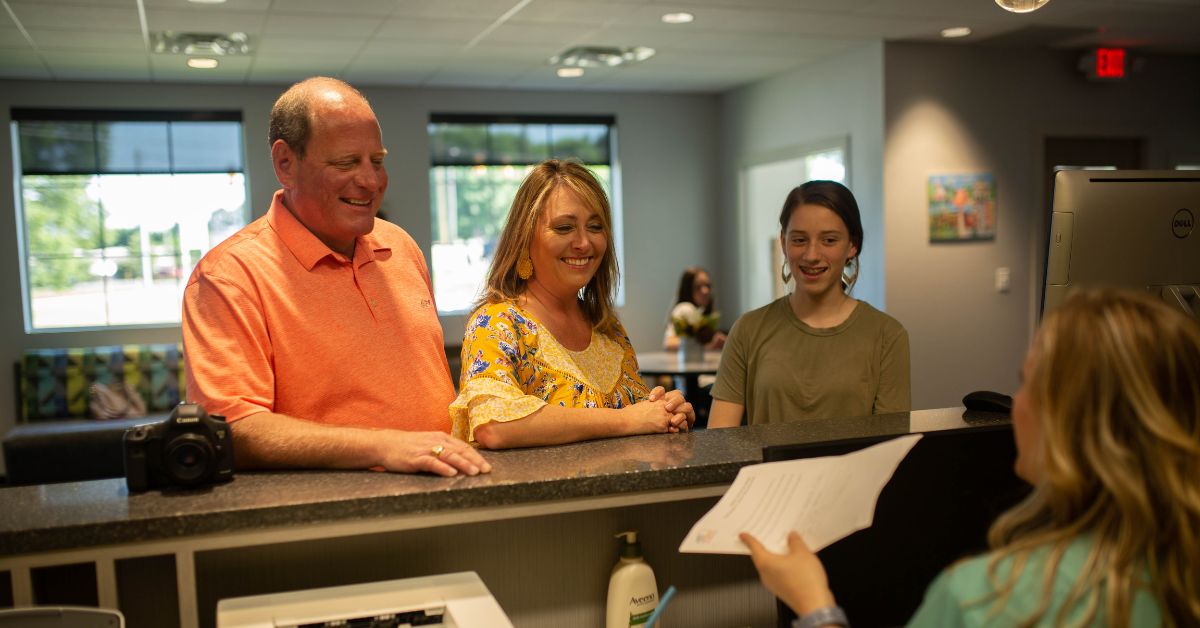While the term “emergency” is often used when describing orthodontic problems, TRUE orthodontic emergencies are extremely rare. The goal of this blog is to explain the different problems that can arise during orthodontic treatment, and provide a guide on how to handle them. Detailed explanations of these issues are also given at your appliance placement appointment regarding these guidelines. Here are a few different types of orthodontic problems and issues you may encounter during treatment, what you can do about them, and, most importantly, how you can prevent emergencies in the future.
Discomfort
There’s no doubt that getting new orthodontic appliances can cause your mouth to feel uncomfortable. However, it can worry a parent to see their child in pain or discomfort. Fortunately, most over-the-counter pain relievers, such as acetaminophen or ibuprofen, can help with the discomfort. Patients can also usually feel discomfort in their mouth after regular adjustments as well. This is a normal sensation and can be easily treated with over-the-counter pain relievers. In general, there is no need to contact your orthodontist for normal orthodontic discomfort.
Irritation or Sores
One of the most common complaints heard by orthodontists is irritation or sores. As your mouth adjusts to your braces or clear aligners, irritation can occur. The simplest fix is to place orthodontic relief wax on the braces, wire, or clear aligner that’s causing irritation or sores. This wax can cushion your mouth and protect it from further irritation, allowing your mucosa (mouth skin) to heal. If you experience these problems, please let your orthodontist or certified orthodontic assistant know at your next appointment. Fortunately, these irritations or sores rarely necessitate an emergency visit to the orthodontist. They can usually be palliated until normal clinical hours.
Loose or Broken Wires
Eating hard, sticky, or chewy foods can cause your wires to become loose or break. Other trauma, such as sports injuries, may also cause this problem. Loose or broken wires may or may not cause discomfort or sores. If the loose or broken wire is not causing discomfort, no immediate action is needed. Simply contact your orthodontist to get an appointment during normal business hours to fix the damage.
When or if the loose or broken wire is causing discomfort, contact your orthodontist to schedule an appointment to correct the problem. If you’re unable to get an appointment quickly, or if this happens after hours or on the weekend, you can easily use a pencil eraser or Q-tip to push the wire flat against their teeth. If that doesn’t work, you may also clip the broken wire to provide immediate relief. To do this, get a small pair of wire cutters or snips, and sanitize them with rubbing alcohol.
Then clip the wire as close as possible to the nearest brace to prevent further problems. You may then place orthodontic relief wax over the affected area to further cushion the irritation. An appointment should be scheduled at your earliest convenience to fix the damage. Again, rarely does a loose or broken wire cause a need for an emergency visit to the orthodontist.
Loose Brackets
From time to time, a bracket can become loose or become dislodged. This occurs for various reasons, but eating hard, sticky, or chewy foods is the main reason it occurs. Placing your fingers in your mouth, and chewing on foreign objects can also cause loose brackets. If the loose bracket is not causing a problem, no immediate action is needed. You should schedule an appointment with your orthodontist during normal business hours to correct the situation.
However, if the loose bracket is causing discomfort, a small amount of orthodontic wax placed over the brace will normally secure it in place and prevent further problems. If the bracket comes off the wire, simply place it in a ziplock bag and bring to the repair appointment. Rarely does a loose orthodontic bracket necessitate an emergency visit to the orthodontist. In general, being mindful of what you eat and keeping your fingers and other foreign objects out of your mouth will prevent this from ever occurring.
Swallowed Brackets
When brackets become loose, they are sometimes swallowed, and the patient doesn’t even know it. This happens from time to time, and is not a major concern.
Although extremely rare, loose brackets may become lodged in the airway. This can cause breathing problems and damage the airway. If this happens, skip the call to your orthodontist! You should go straight to the ER for treatment.
Loose/ Broken Herbst Appliance
The Herbst appliance is an effective tool for correcting overbites. But due to it’s size and design, they do sometimes break or become loose from the teeth. Depending on the problem, your orthodontist can usually walk you through correcting the issue without necessitating an after hours or weekend office visit. However, contact your orthodontist immediately for instructions on how to proceed with fixing the issue.
Trauma
Trauma is the one instance where a TRUE orthodontic emergency exists. The most common causes of orthodontic trauma are related to sports or auto accidents. This is when multiple brackets and/or wires become broken or dislodged. Loose teeth and bleeding gums often accompany this situation. Your orthodontist is ideally positioned to handle these problems. However, problems with the teeth are eclipsed by larger health problems which may be caused by trauma. If an ER visit is needed, address those concerns first, then contact your orthodontist. If the trauma is limited to the mouth and braces, the orthodontist will be able to handle the problem. In the rare case that you cannot reach your orthodontist immediately, or the injury occurs after hours or on the weekend, proceed to the ER until you are able to reach your orthodontist.
What To Do in the Case of an Orthodontic Problem
- Contact Your Orthodontic Office
In case of an issue, we’re always here to aid any problems that arise. No matter the size of the issue, we’re always here for you. Plus, the chances are we’ve dealt with your problem dozens of times and have plenty of experience to handle it. We think of our patients as family and want you to feel as comfortable and stress-free as possible. If you call after hours, our phone system will provide you with our after hours emergency number.
- Keep a Dental First Aid Kit on Hand
It is vital to be prepared for an orthodontic crisis. You can do so by creating a dental dental first aid kit. Your kit should include:
- Floss
- Q-tips
- Orthodontic relief wax
- Topical anesthetic gel, such as Orajel
- Pencil eraser
- Interproximal brush
- Contact number of your orthodontic office
- Keep Your Orthodontic Office’s Phone Number Handy
Orthodontic problems can happen anywhere at any time. As mentioned above, it is vital that you contact a professional and set up an appointment as soon as you can. Keep your orthodontist’s phone number on your phone or carry a business card with you. You should also give the number to your child if they are the patient, and their teachers, babysitters, and family members.
How to Prevent an Orthodontic Problem
- Watch What You Put in Your Mouth
If you have braces, what you eat is incredibly important to your treatment. Certain foods can damage your orthodontic appliances and slow down your treatment process. Since you likely don’t want to keep your appliances on for longer than you have to, make sure you follow the dietary recommendations. While undergoing treatment to straighten your teeth, stay away from sticky, chewy, crunchy, and hard foods. Ignoring a professional’s dietary advice can be damaging to your teeth and your appliances. Hard foods can harm the brackets and sticky foods can break or dislodge the wires. Likewise chewing on foreign objects like pencils and pens, or placing your fingers in your mouth, can easily cause broken or dislodged wires, or broken brackets. Plus, placing these things in your mouth causes a general health problem, as germs are spread via these avenues.
- Practice Good Oral Hygiene
One of the best ways you can prevent orthodontic problems is by maintaining good oral hygiene. Though it is true that problems can happen because of extenuating circumstances, keeping up with dental hygiene can limit your risks. Make sure you are brushing your teeth and flossing after every meal. When you eat, it is easy for pieces of food to become stuck in your braces and teeth. If the particles remain in your teeth, bacteria can multiply, increase plaque build up, and eventually, cause cavities. It is best to maintain and care for your teeth and appliances so you can prevent any damage.
- Be Cautious When Playing Sports
Even during orthodontic treatment, you can still enjoy playing sports. However, you need to be even more cautious than normal. When playing sports, mouth and jaw injuries occur fairly frequently. This is why is it so important to wear a mouth guard when playing sports. This will protect your teeth and braces in case of trauma. There are a few varieties of mouth guards available, including custom fabricated ones made by your orthodontist. Consult with your orthodontist to learn what is best for your needs.
Here’s the Deal:
In summary, rarely does an orthodontic problem necessitate an after hours or emergency visit to the orthodontist. By following the above steps, problems can be easily resolved at home. However, if you have problems or questions, we are always here for you! At Nease & Higginbotham Orthodontics, Dr. Nease will take you through all of your options and guide you through the ups and downs of orthodontic treatment.
Contact us today for an appointment to create beautiful smiles for the Upstate.
Duncan Office
1785 E. Main Street
Duncan, SC 29334
Phone: (864) 579-7700
What is a TRUE Orthodontic Emergency in 2018?




